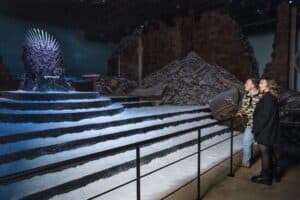Every ancestry journey starts out with two leading questions: who am I, and where do I come from? If you’ve found yourself asking this throughout your life it may be time to take a trip to uncover your heritage and connect to your roots, wherever that may take you.
The Irish diaspora is one of the largest worldwide. Broadly interpreted, the Irish Diaspora refers to all those known to have Irish ancestors, which is estimated at over 100 million people globally. This is almost twenty times the current population of Ireland.
There have been several factors in the mass emigration of Irish people throughout history. The Great Potato Famine in the mid 1800’s, the War of Independence and other elements of British Ruling caused many to flee in search of a more peaceful life. Irish immigrants can be found in almost every corner of the world, but the highest numbers can be found in the U.S., the U.K., Spain, Canada and Australia.
For many people, tracing their ancestry back to Ireland is a thrilling experience. Finding a sense of belonging to a country far away from where you reside can fuel a desire to visit and see for yourself the land your ancestors left behind. Uncovering the roots of your family tree can be an extremely rewarding and emotional experience. It can also be a daunting experience if you don’t know where to start.
This guide is designed to help you get the most out of your search, and hopefully lead you to the most specific details of your heritage, whether you do so from a trip to Ireland or from your own home.
Start at home…
Begin the discovery in your own backyard. Ask around your immediate family for anything that might be helpful: names, dates, addresses, photos. Many families have at least one person keeping track of the family line. If your family has someone like this, ask them questions and find out all you can. Take a slightly bigger step and visit parishes, libraries and any other places that seem to stick out. Gather any information you can from documents like newspaper clippings, tickets, marriage licenses, old diary pages, land records and more. Even the smallest details can lead to the biggest family tree revelations. Combine and organize your data so it’s easy for you to refer to later on. This process may take a decent amount of time or merely a few days, depending on how much you already know.
Put pieces of the puzzle together. There are plenty of ancestry outlets available online to better assist you with this. When it comes to Irish ancestry, we recommend using a program on the Irish Government’s Irish Genealogy website, Family Research 2016. You’ll find portals to archives, registries, learning resources and modules teaching you how to explore your ancestry and get the most out of your research. This resource outlet was created to mark the 100th anniversary of the 1916 Rebellion and is part of the Irish state’s response. Regardless of whether your relatives were part of the event, Family Research 2016 offers the chance of fascinating discovery for all with Irish ancestry. Modules within the website cover surnames, census records, state records of births and deaths, military records and more. Another useful tool is Roots Ireland. This website is run on behalf of county-based genealogy centers. Containing more than 20 million Irish records, this database focuses on Catholic Church records.
Starting at the point you are now, and working your way backwards is the most effective method for most people. After laying the ground work, many people decide to journey to the homeland, where they can visit the places that stand out in their stories. Thankfully, Ireland understands how important heritage is to many of it’s visitors and has created space for many tourists to explore their genealogy. We recommend visiting the following places to enhance your experience and gain invaluable memories and knowledge on where you come from.
National Archives of Ireland and National Library of Ireland
While both are listed for obvious reasons, these Dublin-based resources provide a wealth of information. Professional genealogists at the National Archives offer a free consultation service to give you an extra boost. The library does the same as well as hosting genealogy workshops and talks.
Glasnevin Cemetery Museum
Much more than a cemetery, this award-winning museum is truly an exhibit and homage to Ireland’s great heritage. This Dublin cemetery has more Celtic crosses in one location than anywhere else in the world. It’s considered to be the guardian and storyteller of more than 1.5 million Irish people. You’ll find records dating back to 1828 and a Genealogy Research Center to assist with your ancestry research while you visit. State-of-the-art galleries depict a panoramic view of the cemetery and how it’s changed over time as well as stories of 200 Irish people spanning over two centuries. Glasnevin also conducts tours delving into everything form the 1916 Rising to Irish writers.

Dunbrody Famine Ship
Located in Southeast Ireland, the Dunbrody Famine Ship acts as an authentic reproduction of an 1840s emigrant vessel that many Irish people would have taken to America. A tour gives you the ultimate Irish Emigrant Experience with the likes of costumed performers ready to escape the Famine, an Arrivals Hall that shows what happened if you survived the journey abroad and more. A highlight of this experience is the Irish Emigrant Wall of Honor. Descendants of Irish ancestry from all over the world have had the names of their ancestors inscribed on this wall. You can do this, as well, during your heritage discovery. Should you need a little boost while there, the Dunbrody Famine Ship also has an Irish Emigrant Database for assistance.

EPIC Ireland
What’s not to love about this state-of-the-art journey of the Irish Diaspora brought to life? EPIC Ireland tells the story of more than 10 million Irish people who emigrated from the Emerald Isle and the roots of their ancestors. Twenty interactive galleries illuminate the Irish community’s past, present and future. Upon admission to the museum, you’ll receive a passport to take with you and stamp at each gallery to mark your journey and that of your ancestors. EPIC Ireland invites you to explore the relationship between those who left Ireland and those who stayed behind. You can also visit its Irish Family History Center and meet with a genealogy expert for a consultation to trace your roots while you’re visiting.
Cobh Heritage Centre
Situated within Cobh’s beautifully restored Victorian railway station, Cobh Heritage Centre is perfect for anyone wanting to know more about the Irish Emigration story, their own Irish ancestry, the Irish-built and ill-fated Titanic and even the area’s naval history. Cobh, once called Queenstown, was one of the departure locations for many ships with Irish emigrants heading to America, Australia, England and so many other corners of the map. They left for reasons like the Great Famine or even being banished to Australia and the West Indies as convicts. Exhibits provide a glimpse into Cobh’s past and the hardships many early emigrants experienced. What better way to get in touch with your ancestry than stand on the pier at the exact spot where more than 3 million Irish people departed for the last time?
These are just a few of the many locations Crystal Travel recommends as part of an incredible journey to trace your Irish roots. The answers to your ancestry questions are out there, waiting to be discovered, and we’re happy to help you plan your trip to find them.





